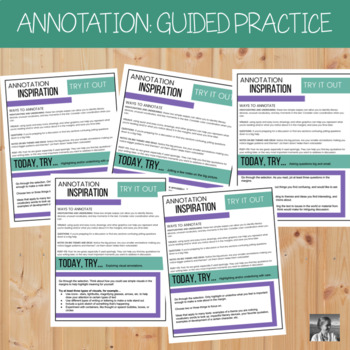Annotating Text: 5 Guided Practices l annotating worksheets
- PPTX
- Google Apps™

What educators are saying
Description
Want to guide students in developing their personal annotation style?
Quality annotation helps kids remember what they read, and discuss and write about it more effectively. But it's tricky to teach, since there isn't really a one-size-fits all approach.
With these guided practices, students can quickly try one targeted technique for annotation, such as highlighting and underlining with color coordination, asking questions in the margins, or using visual elements as part of their annotation. You can use them with any text - whatever you're reading, or modern, relevant short pieces you feel your students will connect to.
Here's what you'll find inside this digital resource on Google slides:
- A poster showing three levels of annotation, from beginner to mastery
- Five guided practices to help students hone their annotation style
- A list of text source options, along with blank slides where you can drop your text selection if you want students to annotate digitally
- Printable bookmarks you can share with students to help reinforce the flexible foundations of annotation
Check out the preview video for an in-depth look at what's inside.
From the Reviews:
"My students found this resource very helpful in annotating for a purpose. Their work definitely improved after working through these practice exercises. I will use them again in the future."
Looking for more annotation resources? Check these out:
Collaborative Annotation: Help students help each other become more skilled at annotation. Students take on annotation roles in a group, then share what they've done and work together to create big-picture questions based on what everyone has contributed.
Annotation Illumination: Show students the power of annotation when they showcase their annotation of one text with color, imagery, and depth. This memorable project will make a great addition to your walls, and help students develop their personal annotation style.
Annotation Posters: Reinforce the creative foundations of effective annotation with these colorful posters.





